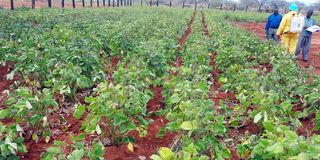Cereal farmers to benefit from Sh9.7bn climate funding

A green grams farm in Kyumani Village, Makueni County.
What you need to know:
- Post-harvest loss is a significant challenge in the country, where a huge percentage of harvested crops are lost annually, leading to financial losses of up to Sh65 billion.
The leading global climate finance body has released $75 million (Sh9.7 billion) in form of a grant to support an initiative that aims to reduce post-harvest losses and improve livelihoods of smallholder farmers in Kenya, and six other African countries.
The Green Climate Fund (GCF), the world's largest fund established in 2010 by the United Nations Framework Convention on Climate Change (UNFCCC), released the funds on February 21, to support different projects that will be implemented under the supervision of AGRA.
“The funds become available immediately, and we thank the GCF for working extremely hard to get the resources to people who need them the most,” said Dr Agnes Kalibata, the outgoing president of AGRA.
The initiative, which is known as Re-gain, was launched during the African Heads of States Food Systems Session at COP28 in Dubai two years ago to enhance African smallholders’ access to technologies, make food loss reduction solutions more accessible and affordable to farmers, and support the creation of enabling environments for transitioning food systems.
According to Mafalda Duarte, the GCF executive director, this is the first programme to come out of the GCF’s Project Specific Assessment Approach (PSAA), whose target is to expand access to funding for organisations that are not accredited to GCF.
The main aim of PSAA is to streamline and broaden access to GCF resources by working with new partners, countries, and technologies, which have been underserved by the existing GCF accredited entity network.
Dr Kalibata notes that one of the main challenges of smallholder farmers in Africa is that they produce a lot of food, but 40 per cent of it goes to waste.
According to John Macharia, AGRA’s country manager for Kenya, the funds will be channeled through cooperatives and the private sector as primary vehicles to invest in post harvest loss reduction technology for the benefit of smallholder farmers.
“We will identify cooperatives in 12 cereal producing counties, through which we will invest in innovations and technologies such as threshing and even value addition, where smallholder farmers can easily access the machineries, standard storage, and different solutions conveniently and affordably,” said Mr Macharia.
Agrodealers will also be equipped with solutions such as hermetic storage bags, which smallholders can easily purchase at affordable prices for safer storage of cereals to reduce the use of pesticide chemicals.
Kenya’s Climate Smart Agriculture Investment Plan notes that post-harvest loss is a significant challenge in the country, where a huge percentage of harvested crops are lost annually, leading to financial losses of up to $500 million (Sh65 billion).
For instance, maize record an average loss of 16.7 per cent, while the dairy sector suffers 4.5 per cent loss, with up to a staggering 50 per cent in certain horticulture value chains. For example, the International Food Policy Research Institute puts mango losses in Kenya at a range of 25 to 44 per cent along the entire value chain, with most losses occurring on the farm, before and during harvesting. The main causes behind mango losses are poor production and harvesting techniques, limited access to inputs such as pesticides, and poor linkages to traders and brokers.
The institute points out that common practices such as shaking of trees or waiting for the fruit to drop to the ground result in the harvest of immature and damaged fruit, while the lack of pesticide use limits protection from physical and physiological damage induced by pests, which results in produce being rejected by traders and processors.
The tomato supply chain has also been identified as one of the crops that incur some of the highest post-harvest losses among fruit and vegetable supply chains in Africa. However, poor handling and transport-related damage results in significant losses of tomatoes.
Some of the common pests associated with post harvest losses in maize include the maize weevils (Sitophilus zeamais) and the larger grain borers (Prostephanus truncatus). Aflatoxin contamination is another major cause of post-harvest losses in Kenya, rendering between 16 and 30 per cent of maize unsuitable for consumption or for the market.
Scientists have warned that the danger of aflatoxin contamination in maize will increase due to climate change.
“We do recognise that post-harvest losses are a critical part of growing markets in the target countries; addressing it will play a critical role in improving food security for farmers, but it is also a critical part of mitigating climate change because if we can save more, we do not need more land to produce more,” said Dr Kalibata.
Apart from Kenya, other countries that will directly benefit from the GCF financing through the Re-gain initiative include Burkina Faso, Ethiopia, Malawi, Tanzania, Uganda, and Zambia.


